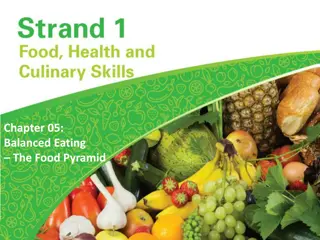Understanding Food Groups and Balanced Diets
Women of reproductive age are vulnerable to nutritional deficiencies, especially during pregnancy and lactation. The Minimum Dietary Diversity for Women indicator is crucial for assessing the micronutrient adequacy of diets. It emphasizes the importance of including various food groups in the diet, such as starchy staples, beans, nuts, dairy, flesh foods, eggs, vitamin A-rich vegetables, and fruits. Local foods like cereals, pulses, nuts, leafy vegetables, and fruits, along with animal products, play a crucial role in ensuring a diverse and balanced diet.
Download Presentation

Please find below an Image/Link to download the presentation.
The content on the website is provided AS IS for your information and personal use only. It may not be sold, licensed, or shared on other websites without obtaining consent from the author. Download presentation by click this link. If you encounter any issues during the download, it is possible that the publisher has removed the file from their server.
E N D
Presentation Transcript
Food groups & Balanced diets
Minimum Dietary diversity - women Women of reproductive age (WRA)1 are often nutritionally vulnerable because of the physiological demands of pregnancy and lactation. These vulnerabilities and gaps in diet quality have been recognised for a long time. The Minimum Dietary Diversity for WRA (MDD-W)3 indicator is a food group diversity indicator that has been shown to reflect one key dimension of diet quality: micronutrient adequacy The MDD-W was developed as a proxy indicator to reflect the micronutrient adequacy of women s diets.
Minimum Dietary Diversity Woman Food groups Sl Food groups 1 All starchy staples 2 Beans & Peas 3 Nuts & seeds 4 Dairy 5 Flesh foods 6 Eggs 7 Vitamin A rich dark green leafy vegetables 8 Other Vitamin A rich vegetables and fruits 9 Other vegetables 10 Other fruits
Name of the food items/varieties Local foods Cereals and tubers Pulses and legumes Nuts and seed/oilseeds Leafy vegetables Yellow/orange/Red fruits and vegetables Other vegetables Other fruits Eggs Fish/Meat/Poultry Milk & Milk products Wild/uncultivated foods (mushroom, bamboo shoots, flowers etc.) collected from village commons including water bodies, forest























